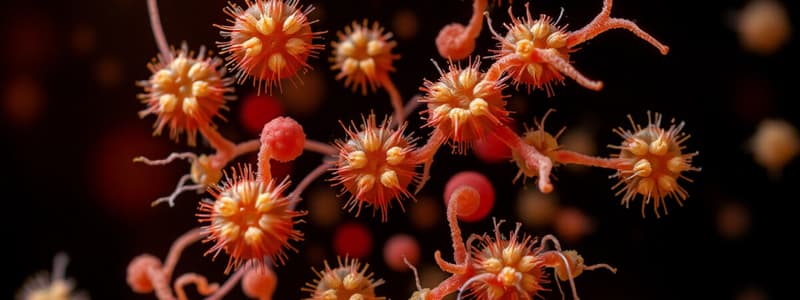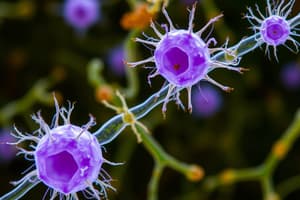Podcast
Questions and Answers
Which of the following statements about microbiology is correct?
Which of the following statements about microbiology is correct?
- Microbiology deals with organisms that can be observed with the naked eye.
- Microbiology focuses solely on viruses and their structures.
- Microbiology includes only those microorganisms that cause disease.
- Microbiology encompasses the study of microorganisms that cannot be seen without specialized equipment. (correct)
Which group of microorganisms is classified as prokaryotes?
Which group of microorganisms is classified as prokaryotes?
- Fungi
- Bacteria (correct)
- Algae
- Protozoa
What percentage of microorganisms are considered beneficial?
What percentage of microorganisms are considered beneficial?
- 70-80%
- 50-60%
- 100%
- 95-97% (correct)
Which of the following is an acellular infectious agent?
Which of the following is an acellular infectious agent?
Which classification is used to group organisms according to the type of cell?
Which classification is used to group organisms according to the type of cell?
Which of the following is characteristic of eukaryotic cells?
Which of the following is characteristic of eukaryotic cells?
What best describes the respiration process in prokaryotic cells?
What best describes the respiration process in prokaryotic cells?
How do prokaryotic cells divide?
How do prokaryotic cells divide?
Which statement correctly distinguishes archaebacteria from eubacteria?
Which statement correctly distinguishes archaebacteria from eubacteria?
What is one key difference in the ribosome sizes of prokaryotic and eukaryotic cells?
What is one key difference in the ribosome sizes of prokaryotic and eukaryotic cells?
Which of the following types of cells can be unicellular?
Which of the following types of cells can be unicellular?
What feature is commonly absent in eukaryotic cells compared to prokaryotic cells?
What feature is commonly absent in eukaryotic cells compared to prokaryotic cells?
Which domain includes organisms such as animals and fungi?
Which domain includes organisms such as animals and fungi?
What defines the number of chromosomes in prokaryotic cells?
What defines the number of chromosomes in prokaryotic cells?
What aspect of eukaryotic cells allows for greater complexity compared to prokaryotic cells?
What aspect of eukaryotic cells allows for greater complexity compared to prokaryotic cells?
Flashcards
What is Microbiology?
What is Microbiology?
Microbiology is the scientific field that studies microorganisms, which are living things too small to be seen with the naked eye.
Microbial World
Microbial World
The microbial world encompasses all the microbes, including bacteria, algae, fungi, protozoa, and helminths.
Classification of Microorganisms
Classification of Microorganisms
Microorganisms are classified into two main groups: prokaryotes and eukaryotes.
Prokaryotes
Prokaryotes
Signup and view all the flashcards
Eukaryotes
Eukaryotes
Signup and view all the flashcards
Prokaryotic Cell
Prokaryotic Cell
Signup and view all the flashcards
Eukaryotic Cell
Eukaryotic Cell
Signup and view all the flashcards
Bacteria
Bacteria
Signup and view all the flashcards
Archaea
Archaea
Signup and view all the flashcards
Peptidoglycan
Peptidoglycan
Signup and view all the flashcards
Sterols
Sterols
Signup and view all the flashcards
Nucleoid
Nucleoid
Signup and view all the flashcards
Nucleus
Nucleus
Signup and view all the flashcards
Organelles
Organelles
Signup and view all the flashcards
Chromosomes
Chromosomes
Signup and view all the flashcards
Binary Fission
Binary Fission
Signup and view all the flashcards
Mitosis & Meiosis
Mitosis & Meiosis
Signup and view all the flashcards
Respiration
Respiration
Signup and view all the flashcards
Three Domain System
Three Domain System
Signup and view all the flashcards
Study Notes
Pathogenic Microorganisms - 222 PHARM
- Topics covered include introduction to microorganisms, objectives, microbiology definition, scope of microbiology, classification of living organisms, prokaryotic and eukaryotic cells, prokaryote vs eukaryote, domains, kingdoms, binomial nomenclature system of classification, bacterial shapes, and bacterial arrangements.
- Microbiology is the study of very small living organisms (microorganisms, M.O.) that cannot be seen with the naked eye.
Introduction to Microbial World
- Microbiology is the study of living things too small to be seen without a microscope.
- Microorganisms can be beneficial or pathogenic.
- Microorganisms include bacteria, archaea, fungi, protozoa, algae, and viruses.
Objectives
- Define microorganisms and the scope of microbiology.
- Understand the microbial world and microbial classification.
- Differentiate prokaryotes and eukaryotes.
- Describe various types, shapes, and arrangements of microorganisms under a microscope.
What is Microbiology?
- Microorganisms (M.O) are too small to see.
- Microbiology studies M.O,
- Most microbes are beneficial,
- Medical microbiology studies disease-causing microbes.
Scope of Microbiology
- Infectious agents – includes bacteria, fungi, protozoa, helminths and viruses.
- Viruses are acellular, non-living agents.
Classification of Living Organisms
- Based on cell type (prokaryotic/eukaryotic)
- Based on domains (Woese et al. 1990) -> Bacteria, Archaea, Eukarya.
- Based on kingdoms (Cavalier-Smith 2000) -> example Archaebacteria,Eubacteria, Animalia, Plantae,Eumycota, Protista, Chromista.
Prokaryotic & Eukaryotic Cells
- Prokaryotic cells lack a nucleus and other membrane-bound organelles.
- Eukaryotic cells have a nucleus and membrane-bound organelles. (Visual aid included)
Prokaryote vs. Eukaryote
- Key differences in cell structures and organization. (Data Table included)
Domains
- Three domains exist: Bacteria, Archaea, Eukarya.
Kingdoms
- Six (or seven) kingdoms of living organisms are present. Examples include : Archaebacteria, Eubacteria, Animalia, plantae, fungi, protista, Chromista.
Binomial Nomenclature System
- Organisms are named using a two-part naming system: Genus species (e.g., Staphylococcus aureus).
- Genus is capitalized and species is lowercase.
- Both are italicized.
- Genus can be abbreviated (e.g., E. coli).
Bacterial Shapes
- Three basic shapes: Bacilli (rod-shaped), Cocci (spherical), Spiral (helical).
- Some bacteria are pleomorphic—meaning their shape varies.
Bacterial Arrangements
- Cocci can arrange in various patterns (e.g., diplococci, streptococci, tetrads)
- Bacilli can arrange in patterns (e.g., single, pairs). (Visual representation of arrangements included)
Studying That Suits You
Use AI to generate personalized quizzes and flashcards to suit your learning preferences.




